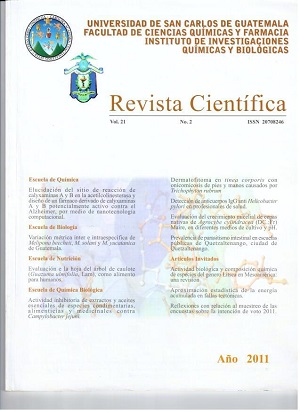Mycelial body growt evaluation of Agrocybe cylindracea native strains (DC.:Fr) Maire in different culture media and pH
Keywords:
Mycelial growth, fruiting bodiesAbstract
Evaluation of mycelial growth of Agrocybe cylindracea native strains (DC.: Fr) Maire, in different culture media and pH
ABSTRACT
Agrocybe cylindracea is a fungus that is consumed in the municipality of Tecpán Guatemala, Chimaltenango; San Juan Ostuncalco, Quetzaltenango and villages Escuachil and Vista Hermosa Sacatepéquez San Antonio, San Marcos. In the present study used five strains of A. cylindracea Guatemalan, determining colonial morphology and mycelial growth in different culture media and pH, the best condition for cultivation in the laboratory as a preliminary step to obtaining fungal biomass, and seed production of fruiting bodies. It was determined that all colonies of the strains tested showed the morphological characteristics reported in the literature for A. cylindracea (except for the amount of aerial mycelium which was abundant) in all media and pH studied. In evaluating mycelial growth as culture media using potato dextrose agar (PDA), malt extract agar (EMA), and cornmeal agar and yeast (CMYA), adjusted to pH 5, 5.5 and 6 and incubated at a temperature of 26 ° C, it was determined that the culture medium at pH 6 EMA favored the growth of most strains. In assessing the interactions between strain, culture medium and the pH was observed that the mycelial growth combined with greater strains were obtained with 638.08 and 58.01 in the media PDA and EMA at pH 6. Additionally, strain EMA 638.08 in the middle can have good performance at pH 5 and 5.5. As a consequence of the results, we recommend the cultivation of both strains under the conditions indicated for mycelial biomass production as a precursor to the production of inoculum and fruiting bodies.
Keywords: Mycelial growth, fruiting bodies
Â
References
REFERENCIAS
Bran, M., Morales, O., Cáceres, R. y Flores, R. (2003). Contribución al conocimiento de los hongos comestibles de Guatemala.
Universidad de San Carlos de Guatemala. Facultad de Ciencias Químicas y Farmacia. Instituto de Investigaciones Químicas y Biológicas. Rev. Cient. Guat. 1(1):3-24.
Bueno, L. y Gallardo, R. (1998). Preservación de hongos filamentosos en agua destilada estéril. Rev. Iberoam. Micol. 15:166-168.
Cantrell, H. & Dowler, W. (1971). Effects of temperature and pH on growth and composition of Pythium irregulare and P. vexans. Mycol. 63:31-37.
Chang, S. & Miles, P. (2004). Mushrooms cultivation, nutritional value, medicinal effect and environmental impact. 2a. ed. USA: CRP. Press. 451p. p.2, 6, 193.
Dix, N. & Webster, J. (1995). Fungal ecology. London: Chapman & Hall. 549p. p.186-188.
Dudchenko, L. & Semichaevsky, G. (1989). Effect of pH of the medium on the production of extracellular enzymes by wood-destroying Basidomycetes. Rev. Plant. Pathol. 22(2):135-141.
Fries, L. (1956). Studies in the physiology of Coprinus. II. Influence of pH, metal factors and temperature. Sven. Bot. Tidskr. 50:47-96.
Hostnig, R. Hostnig, V. & Vásquez, L. (1998). Etnobotánica Mam. Guatemala: GTZ-Helvetas. 366p. 90p.
Huitz, P. (2009). Crecimiento miceliar y caracterización macro y microscópica de cepas nativas del hongo comestible Asam (Schizophyllum commune Fr.). Guatemala: Universidad de San Carlos de Guatemala (Trabajo de graduación, Facultad de Ciencias Químicas y Farmacia). 58p.
Maekawa, N., Fukuda, M., Arita, T. & Komatsu, M. (1990). Effects of liquid-nitrogen cryopreservation on stock cultures of three cultivated basidiomycetous fungi. Rept. Tottori. Mycol. Inst. 28:227-232.
Mier, T., Toriello, C. y Ulloa, M. (2002). Hongos microscópicos saprobios y parásitos: Métodos de Laboratorio. México: Universidad Nacional Autónoma de México. 34p.
Morales, O. (2001). Estudio etnomicológico de la cabecera municipal de Tecpán Guatemala, Chimaltenango. Universidad de San Carlos de Guatemala (Tesis de graduación, Facultad de Ciencias Químicas y Farmacia). 92p.
Morales, O., Bran, M., Cáceres, R. (2010). Los hongos comestibles de uso tradicional en Guatemala. En: D. Martínez-Carrera, N. Curvetto, M. Sobal, P. Morales & V. M. Mora. (Eds.). Hacia un Desarrollo Sostenible del Sistema de Producción-Consumo de los Hongos Comestibles y Medicinales en Latinoamérica: Avances y Perspectivas en el Siglo XXI. México: Red Latinoamericana de Hongos Comestibles. p.437-464.
Nobles, M. (1965). Identification of cultures of wood-inhabiting Hymenomycetes. Can. J. Bot. 43:1097-1139.
Poucheret, P., Fons, F. & Rapior, S. (2006). Biological and pharmacological activity of higher fungi: 20-year retrospective análisis. Cryp. Mycol. 27(4): 311-333.
Salmones, D., Gaitán, R., Pérez, R. y Guzmán, G. (1997). Estudios sobre el género Pleurotus. VII. Interacción entre el crecimiento miceliar y la productividad. Rev. Iberoam. Micol. 14:173-176.
Sánchez, J., De León, R. y Huerta, G. (2000). Efecto del pH, temperatura, humedad y tipo de substrato sobre el crecimiento micelial de Ganoderma lucidum. Rev. Mex. Mic. 16:37-40.
Stamets, P. (1993). Growing Gourmet & Medicinal Mushrooms. WA, USA: Ten Speed Press & Mycomedia. Olympia, WA, USA. 554p. p.30, 113, 126, 220.
Fries, L. (1956). Studies in the physiology of Coprinus. II. Influence of pH, metal factors and temperature. Sven. Bot. Tidskr. 50:47-96.
Uhart, M. & Albertó, E. (2007). Morphologic characterization of Agrocybe cylindracea (Basidiomycetes, Agaricales) from America, Europa and Asia. Rev. Mex. Mic. 24:9-18.
Yamanaka, T. (2003). The effect of pH on the growth of saprotrophic and

